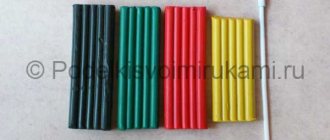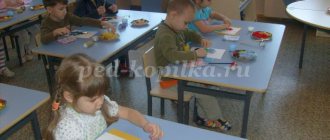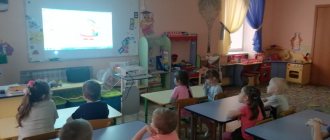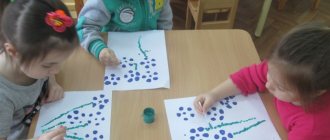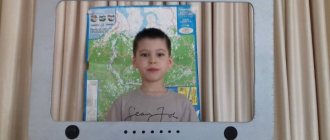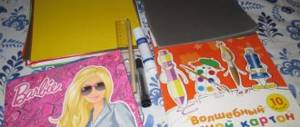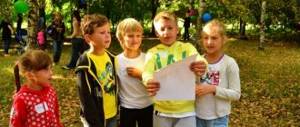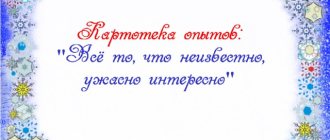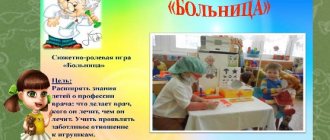Thematic planning in the senior group on the topic “Mother’s Day”
1) Morning – meeting of children and parents. Game “Parents” (What is the facial expression of mom and dad when they are angry? What do you do when you are scolded? How do dad and mom smile when they hug you?).2) Preparing for breakfast. Complex of morning exercises. Articulatory gymnastics "" (card file of articulatory gymnastics).
3) Breakfast. Conversation “Vitamin food always gives us strength” (To consolidate children’s knowledge about balanced nutrition. To consolidate children’s compliance with nutritional rules).
4) Preparing for a walk. Conversation with children: about what they did yesterday; What are your plans for today, the children’s wishes. Pictures, illustrations “Helping Mom.” Illustrations depicting various professions. D/i “Chicken Family” (exercise children in recognizing and naming geometric shapes, developing children’s logical thinking) Work in the book corner “Bookmark for a book.”
5) Walk. Observing snowfall (form an idea of the properties of snow; consolidate knowledge about the seasonal phenomenon - snowfall) Draw attention to falling snow. Reach out your mittened hand and catch a few snowflakes. Examine them (size, find the same ones) Labor - clearing the area from snow (teaching how to collect snow, pouring it in a certain place) P/i “Geese-swans”, “Who will jump better?” (continue to learn how to correlate your own actions with the actions of the participants in the game; consolidate the ability to jump.
6) Preparing for lunch. Reading E. Uspensky “If I were a girl.”
7) Lunch. Conversation “Why do we eat?” (a person eats to live) Food is not only a source of energy necessary for human activity, but also a material for growth and development.
 Preparation for sleep. Rinse your mouth after eating.
Preparation for sleep. Rinse your mouth after eating.
9) Daytime sleep.
10) Raising children. Walking barefoot on rugs. Corrective gymnastics “Getting ready to draw (using self-massage of the hands) Strengthen the ability to dress independently, help each other. Breathing exercise “Snowflakes” (card file of articulation gymnastics) Arrange chairs in a certain order.
11) Afternoon snack. Game “Yes, no” (And in order for food to be well absorbed, you need to follow the nutritional rules. I will now read the rules to you, and if you agree with me, then show me the green signal of the card. If not, red.)
12) Preparing for dinner. D/i “What music?” (develop the ability to listen to music, enrich children’s statements about the emotional and figurative content of music) Wash and wipe toys and building materials. Wash combs, lay out soap. Construction “Building a turret and a fence for a bird, a house for a dog” (teach to use the acquired skills and abilities when building a turret and a fence for a bird, a house for a dog) Theatrical performance “At a doctor’s appointment.”
3) Dinner. The plot is a role-playing game “Beauty Salon” - a mother is going to kindergarten for a holiday. (To expand and consolidate children’s knowledge about working in the “Beauty Salon”, to create a desire to look beautiful, to cultivate a culture of behavior in public places, respect, polite treatment of elders and each other.)
Planning a theme week
A thematic week may include events of various types: sporting events (“Mom, Dad, I am a sports family”, physical education sessions with family songs, family matches, etc.), exhibitions and competitions of drawings and crafts, conducting research, defending projects, holding conversations, watching films and cartoons on a certain topic.
Family weeks in kindergarten are a good way to unite the team
Target
The purpose of the thematic week is to develop in children an idea of family life and relationships in it (mutual help, support, distribution of household chores, spending time together), as well as the value for each person.
Lexical topic
The lexical topic is also intended to tell children about the family, its importance, composition and relationships between members. But the main goal of this topic is to expand and update vocabulary and develop speech.
For your information! A lesson on this topic can be conducted both in a general education preschool educational institution and in groups for children with delayed speech development.
A good exercise can be to select adjectives that characterize each family member. For example, dad (smart, strong, caring, resourceful, loving us and mom), grandmother (sweet, kind, forgetful, loves to cook).
It is also useful to compare the ages of family members (who is older and who is younger).
Based on the results of a family portrait or craft, compose a short story about your loved ones, talking about the composition, joint activities, and household chores.
It is useful to carry out physical education while listening to a family song.
Final event
Note! For the final event, in order to spend time together and strengthen family relationships, it is necessary to hold the event together with children and their family members.
A sports holiday “Mom, Dad, I – a sports family” is suitable. The event is held in the kindergarten gym or on the playground, weather conditions permitting. Each family forms a team with its own visual identity, name and motto, which will also be judged.
Tasks for the sports festival:
- "Bowling". Who will knock down more pins with the ball?
- "Get in the basket." Who will throw more balls into the basket with the same number of attempts?
- “Rip it off!” It is necessary to jump a distance while sitting on a fitball and, returning to the team, pass the ball to the next participant.
- "Darts". Calculation of the greatest number of points.
- "Captains Competition" The task is to carry a ping pong ball in a spoon, which must be held in the mouth.
- "Running in sacks." A relay race in which the entire team takes turns jumping a distance in bags.
Running in felt boots not only entertains, but also develops
- "Obstacle course." The task is in the form of a relay race to go through an impromptu obstacle course (jump over a bench, run along a bench, run around a cone, etc.).
- “Resolve!” Team solving puzzles on a family theme.
- “Pull!” Tug of war.
- "Fun Basketball" Who will score more balls into the net with an equal number of attempts.
- "Felt boots". Running in felt boots.
At the end of the event, points are counted, winners are determined, diplomas are awarded to winners and participants, as well as symbolic prizes. The sports festival ends with tea. It is also allowed to integrate creative events into the sports festival.
Mini project
Mini-project: “My family tree.”
Goal: to see and strengthen family ties, to realize oneself as part of a large and friendly family.
How to teach your child to use a pencil or pen correctly
Each child is given the task of drawing up a family tree on whatman paper at home together with their parents. You need to do the following:
- depict a tree;
- paste photographs of family members;
- sign their surnames, first names and patronymics, years of birth and death (if no longer alive) and occupation.
Making a family tree will be beneficial
The result of this task will be the defense of your mini-project together with one of the family members (or an open lesson).
For your information! It is important that the parent helps his child prepare the project.
Long-term event planning table
Long-term planning is designed to help the teacher competently plan his activities. Planning facilitates the teacher’s work process and increases the effectiveness of the classes, since it makes it possible to distribute topics and knowledge given to children in the required sequence, interconnected, from simple to complex. Planning must be done for each calendar year.
GCD on the topic “My Family”
Goal: to instill in children the importance of family for a person and its value in the modern world.
Equipment:
- laptop;
- loudspeakers;
- recording of the song “There are one hundred thousand I in the word family”;
- an application in the form of photographs from the family archive;
- tables;
- drawing paper;
- Gouache paints;
- brushes;
- water containers;
- simple pencils;
- erasers;
- matryoshka
Preliminary work: bring photographs of your relatives, as well as photos of them as children.
Progress of the lesson (the lesson begins with listening to a song and discussing it, the teacher asks about the meaning of this song):
- “Children, what do you think this song is about? Right. That a family consists of several people who are united, live one for all and all for one, and do not leave each other in trouble. If you are surrounded by reliable people, then you won’t have any problems.”
- “Previously, the family symbol was the matryoshka doll. Why? Look at her carefully. Everyone has their own responsibilities because it makes life easier. Each one knows for sure that the other will not let him down and will do his job. How are your responsibilities distributed?
- “Now, please prepare the photographs that you brought from home. These photographs show members of your family. Now each of you will tell us about your relative. For some it is a grandmother or grandfather, for others it is a brother or sister, and for others it is an aunt or uncle.”
- “Tell us about his best qualities, what he likes, how you spend time together, and how often you see each other. Maybe you want to change something in your communication?
- “Another homework assignment was to bring photographs in which relatives are depicted as small children. Who brought it? Show them to everyone and tell them who is depicted on them. Look how interesting it is that adults today used to be kids like you! We also played, made friends, quarreled, walked, chased birds, also went to kindergarten, had a fun summer.”
For your information! At the end of the discussion, the teacher invites the children to paint a portrait of a relative in gouache.
Modeling in the middle group on the theme “Family”
It is important that modeling classes, like drawing, develop fine motor skills of the hands, which contributes to a more rapid development of the child’s speech according to the Federal State Educational Standard. Many materials are suitable for modeling in the middle group:
- plasticine;
- salty dough;
- clay.
Modeling develops thinking and motor skills
Since clay is a more labor-intensive material to prepare, it is recommended to prepare it for use by children. Salt dough can be prepared together with preschoolers.
Theme of the lesson: “My family.”
How to teach a 4-5 year old child to draw
Equipment:
- plasticine;
- stacks;
- tables;
- plastic napkins.
Progress of the lesson (the teacher tells the children about the value of family):
- “Guys, why is family so important for a person? Maybe it’s easier to live alone”?
- “Family is a person’s support, his support. People should support each other, be tolerant and help. And one person lives alone, with no one to give a helping hand in difficult times.”
- “Are your family friends? Would you like to start your own family in the future?
- “Let’s now each imagine our family and try to mold it.”
- “I recommend using different colors, or you can choose a specific color for everyone. And when you finish sculpting, then let’s talk about what duties each relative performs in your house.”
Application on the theme “Family” in the preparatory group
Application promotes the development of compositional thinking, develops fine motor skills, imagination and aesthetic taste. Any type of paper is suitable for application:
- special color;
- packaging;
- newspapers and magazines for individual parts;
- colored cardboard;
- corrugated and others.
For your information! You can also use different applique techniques: the “torn paper” technique, using geometric shapes, silhouettes, and more.
Application theme: “My family together.”
Goal: to teach preschoolers to cut out silhouettes of the desired shape, create a composition from them, and instill the concept of the value of family and the importance of spending time together.
Equipment:
- tables;
- glue stick;
- safety scissors;
- simple pencils;
- erasers;
- markers;
- white cardboard for the base;
- colored paper;
- corrugated paper;
- colored cardboard;
- newspapers;
- magazines;
- wrapping paper;
- various candy wrappers;
- samples of applications made using various techniques.
Progress of the lesson (the teacher begins the lesson with a short conversation):
- “Guys, when can the whole family get together? As a rule, this is either in the evening, when all family members are at home (some have returned from work, some from school, some from kindergarten), or it is a day off, or a holiday, when no one needs to go to school. work and study."
- “Do you ever have such a time in your family? If the family is large, then maybe not often, because everyone has their own things to do. And if the family is smaller, it’s easier to get together.”
- “Remember such a time, imagine it and try to depict it using appliqué. Maybe this is the time when you all watch your favorite series or family movie together, or drink tea with cookies, or walk the dog.”
- “You can use any paper for your work.”
After the children finish the appliqué, everyone will talk about what they depicted.
For your information! An application on the topic “Family” in the senior group can be carried out using the same materials.
